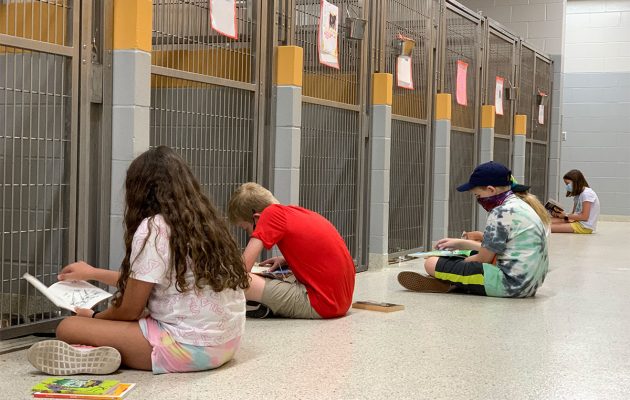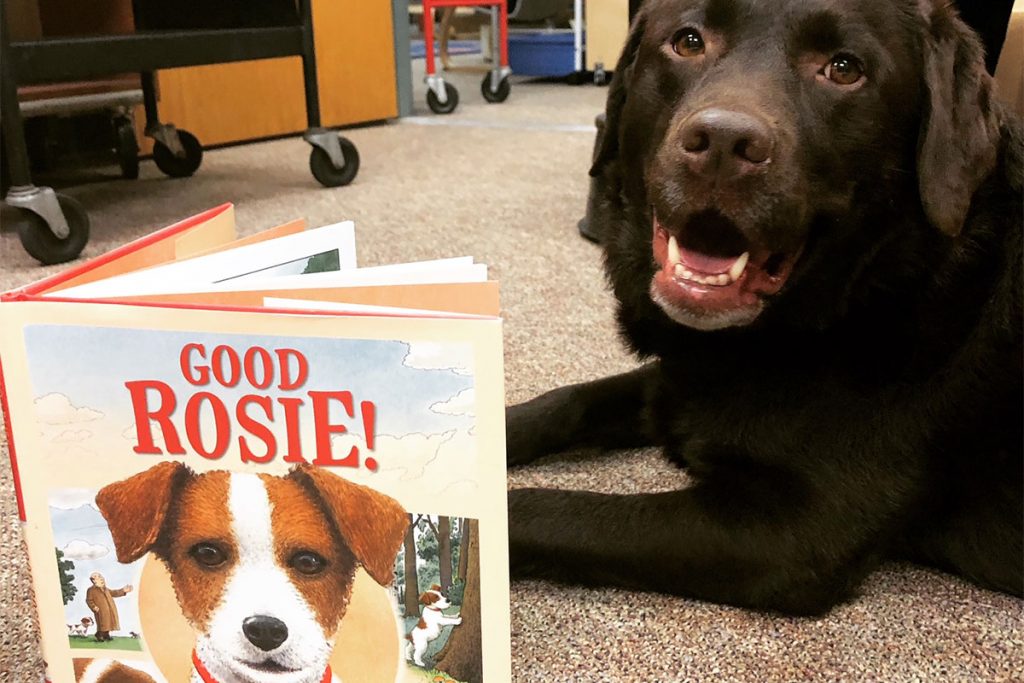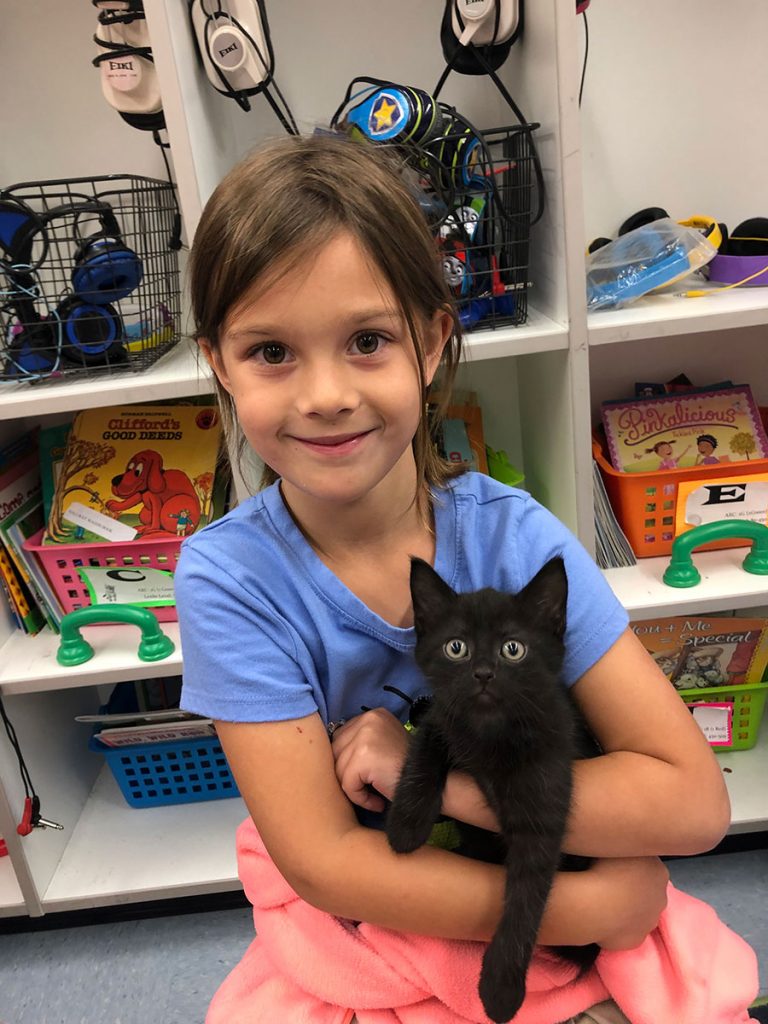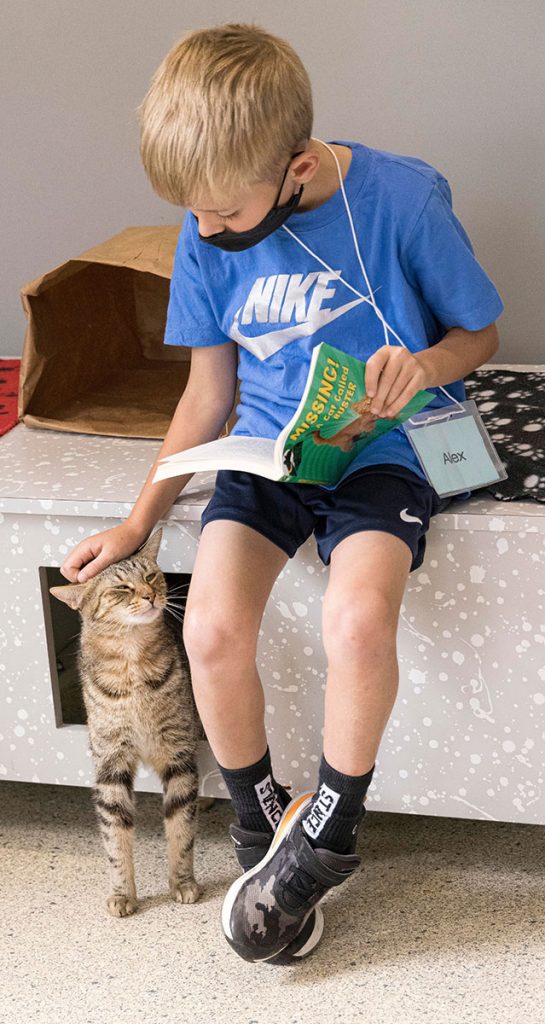ANIMAL TEACHERS

When schools open in August, students will be welcomed back by more than just teachers, administrators and staff. In some school classrooms, a variety of friendly classroom pets and animal reading companions will enrich and expand traditional learning, according to longtime educators Ana Andenmatten and Laurie Wilbur.
Both women are teachers and mothers with decades of childhood learning experience. They promote the value of animals in the classroom to motivate and excite children about learning, especially children with no pets at home. They say that interaction with classroom pets, or reading to an animal provides powerful incentive for students to focus on assignments and put forth their best efforts while practicing skills and building confidence.
Ana Andenmatten, a first grade teacher at Mandarin Oaks Elementary and founder of Ana’s Angels Animal Rescue, provides classroom pets and foster animals to interact with her students. Laurie Wilbur and her chocolate Labrador Retriever, Rosie, spearheaded a Read With Me initiative in schools that has grown to ten reading teams since 2018.
Mrs. Andenmatten’s fifteenth year of teaching begins in August. She said that classroom pets can teach children valuable life lessons equally as important as grade-level curriculum. As an experienced elementary teacher, including special-needs students and those whose first language is not English, Andenmatten said that all young learners uniquely respond to animal interaction.
“As we care for classroom pets or rescued animals, these activities teach the importance of daily routine and responsibility. During the year, students learn empathy and compassion, because our animals were homeless, have obvious disabilities, or are healing from temporary or permanent injuries. Each time they clean up after, feed, water, play with or walk an animal, they learn to think of the needs of others. Students also learn how to calmly approach or properly handle an animal, including safety and cleanliness. Students are introduced to animal rescue, rehabilitation, socialization, training and fostering-to-adoption, including how to say goodbye when a foster goes to its new home,” she said. “When a foster is adopted we post photos for the entire school to celebrate that adoption together.”
While foster animals rotate in and out of the classroom as they are adopted, Andenmatten’s permanent classroom residents include a rescue hedgehog named Hedgie and a chinchilla named Chinny Chin Chin. Andenmatten said every child has a daily job to compete for the animals. After school work is finished, the reward is time to pet or play with the animals.
Animal activities complement science curriculum studies and projects, including hatching baby chicks from eggs in an incubator. Ecology and environmental lessons come alive with an outside garden perfect for hedgehogs. Reading to Hedgie is considered a class privilege; the children truly believe he listens attentively to them. They don’t seem to mind at all that the nocturnal hedgehog who enjoys many hours of daytime sleep, often snoozes straight through storytime.
Andenmatten does not accept animals from the public, but pulls them from shelter euthanasia lists or from situations where necessary veterinarian, surgical care or longterm rehabilitation is unavailable. Her safety net also includes rescue of animals with the least probability of adoption: senior or disabled pets, those with obvious deformities, and animals with solid black fur. She is always astonished at how first-graders do not hesitate to accept physical differences that cause most potential adopters to reject animals.
“I talk to my students about possible foster pets and discuss if they are comfortable with having a particular animal in the classroom. Green Bean, a kitten born without paws who could not walk normally is a perfect example. I choked up when eighteen little faces nodded yes to Green Bean without hesitation. Spending time with Green Bean is going to help them accept and better understand others with differences, throughout their lives,” she said. “It is so endearing to see them carefully spread their jackets under their desks, inviting Green Bean, because he is more comfortable lying on cloth than tile.”
Andenmatten’s outside-the-box creativity, and her animal teachers, have proven so successful and popular, there is a waiting list for her classes. Waiting list requests and other parental options are only available at some public schools. Students must be allergy-free and parental permission is required for students to interact with classroom animals. Ana’s Angels Animal Rescue is a nonprofit, with all tax-deductible donations entirely used for animal rescue, food, supplies and veterinary care.
Laurie Wilbur and her chocolate lab Rosie volunteered to spearhead the Read With Me program in 2018, a special initiative of Pet Partners of Northeast Florida. The program trains, tests and registers a human/animal team for school visits. There are two types of program activities: younger children practice their literacy skills and gain confidence by reading aloud to the animal, or for teens, the teams offer companionship, emotional support, positive interaction and personal connection, or stress relief.

Wilbur visits school principals to explain the program and its broad benefits for students and teachers. The first school visit was to Seabreeze Elementary in 2018. Then she and Rosie began to visit Mandarin Oaks Elementary and Paxson High School. There are now ten Read With Me teams that include dogs, a cat and a rabbit, that are all available to visit schools, Wilbur said. She actively recruits new teams and welcomes principals to contact her about the program.
“When I heard that Pet Partners of Northeast Florida needed a volunteer to coordinate a local Read With Me program, I knew that Rosie and I were the perfect fit,” Wilbur said. “Sometimes it’s children reading to Rosie or teenage students who sign up for lunch visits. All kinds of students want to connect and relax with an affectionate animal, or talk to a caring adult with no agenda but a sympathetic ear. This program offers benefits for all ages. The animals especially help children who are learning English, the disabled, autistic or those with other physical, emotional or learning challenges. Teams also teach children how to safely and properly greet, approach and interact with animals.”

Wilbur said that visits are closely coordinated with the schools and parental consent is required for participation. The Read With Me teams have attended 2021 summer camps and are ready to resume a normal school visitation schedule for the 2021-2022 academic year. Adult handlers and their animals must complete obedience training, testing and registration requirements as a pet therapy team through Pet Partners of Northeast Florida in order to participate.
Children reading to animals has also been a success at the Jacksonville Humane Society. Their highly successful Pawsitive Reading Program, sponsored by The Jim Moran Foundation, has attracted approximately 1100 families since 2018 and several hundred regular weekly or monthly readers. Participants visit the shelter to read to the animals, which allows them to practice reading skills and build reading confidence in a safe, fun environment. The reading sessions also provide valuable enrichment for shelter pets who miss human interaction and contact, according to Savanna New, M. Ed., Jacksonville Humane Society’s Development & Education Manager.

“Attendance at one, free forty-five minute information session by the child and parent/guardian, with advance registration, is required. Pawsitive Reader information sessions resume in August and quickly fill. Check the JHS website for information,” New said. “We welcome all ages, including pre-readers whose parents or guardians can read to them while our shelter pets listen. While promoting literacy skills for children, this program provides socialization, companionship and stress relief for shelter pets, helping better prepare them for adoption.”
Pawsitive Readers may come to the shelter anytime during Adoption Center hours, weekdays 12 p.m. – 7 p.m. or weekends 10 a.m. – 5 p.m., to read to shelter pets. A parent or guardian must stay with their child throughout the reading session. Suggested reading time for maximum benefit to the animals and readers, is at least thirty minutes per visit. Readers choose to read to adoptable cats or dogs from their own books or books may be borrowed from the Pawsitive Reading Library. All participants receive a free book, courtesy of The Jim Moran Foundation, while supplies are available. Teen Pawsitive Readers complete community service volunteer hours required by schools, while helping animals in need.
The required Pawsitive Reading Information Sessions will be held in August: Saturday, August 7, 10:30 a.m.; Thursday, August 12, 5:00 p.m.; Wednesday, August 18, 5:00 p.m.; Tuesday, August 24, 5:00 p.m. Advance registration is required and can be completed online. Sessions are held at the Jacksonville Humane Society, 8464 Beach Boulevard, in the conference room above the adoption center.
By Julie Kerns Garmendia
Resident Community News






